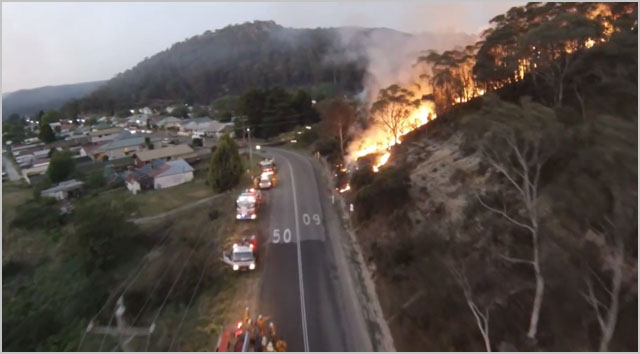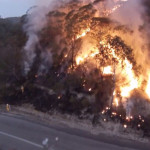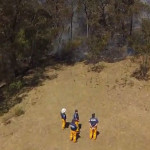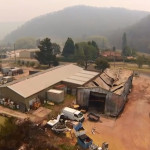
news The Civil Aviation Safety Authority has issued a strongly worded statement warning the operators of small remotely piloted drones which have produced amazing footage of bushfires in the Blue Mountains that they are putting fire fighting operations at risk and should be aware of appropriate regulations.
Over the past week at least one visually stunning video of bushfires in the Blue Mountains, taken at Lithgow, has surfaced on YouTube. Set to sombre music, the video shows a close-up video of the dangerous bushfires being fought by firefighters, as well as devastated bush and suburban areas. The video features footage which would be impossible to obtain through filming from a helicopter, and is set to sombre music. Still photos from the footage are published in this article to give a flavour of the footage, although readers are recommended to view the video themselves.
However, the Civil Aviation Safety Authority late last week published a sattement warning drone operators that they were putting fire operations “at risk”.
“The Civil Aviation Safety Authority has seen video footage of a remotely piloted aircraft being operated on the NSW Lithgow fire ground this week,” the regulator said. “This operation was not approved and appears to be in breach of Civil Aviation Safety Regulations.”
“Flying a remotely piloted aircraft in the same airspace as fire fighting helicopters and aeroplanes creates a real risk of a mid-air collision. If a remotely piloted aircraft hit a fire fighting helicopter tail rotor the helicopter could be badly damaged, with possible loss of control by the pilot. The collision risk means if unapproved remotely piloted aircraft operate on a fire ground fire fighting authorities may be forced to ground their aircraft, putting lives and property at risk.”
CASA’s Director of Aviation Safety, John McCormick, said the unapproved use of remotely piloted aircraft during a bush fire was irresponsible.
“People who have a ‘drone’ must fly according to the Civil Aviation Regulations and they must use their common sense,” McCormick said. “Flying an unapproved remotely piloted aircraft near fire fighting aircraft, fire fighters and fire fighting vehicles is dangerous.”
Operators of both commercial and recreational remotely piloted aircraft are required to comply with Part 101 of the Civil Aviation Safety Regulations. The regulations include provisions requiring remotely piloted aircraft not to operate closer than 30 metres to people unless otherwise approved. It is also an offence to operate a remotely piloted aircraft in controlled or restricted airspace without approval or to operate in a way that creates a hazard to another aircraft, person or property.
Media are asked not to use vision or photographs taken from unapproved remotely piloted aircraft operations as this can promote dangerous activities. The rules for use of remotely piloted aircraft are available online in CASR Part 101 Unmanned aircraft and rocket operations.
opinion/analysis
So where should we stand with relation to this kind of footage? Is CASA right? Does the use of drone footage in these kinds of situations pose a risk to fire fighting operations? Should drone operators stay away from such zones? Or does the operation of these drones have some merit that should also be considered?
The first thing that no matter what the regulator thinks, this kind of activity will happen anyway. There is absolutely no doubt that this sort of activity will be ongoing. It’s extremely hard to police, and like most of Australia’s government regulators, CASA will no doubt be extremely slow to move against individual drone operators, even if it is able to determine which particular operator was flying their drone across a certain fire area or other disaster zone. In addition, drones are becoming more and more ubiquitous as the technology becomes cheaper and easier to access.
Then, too, the footage produced by these kinds of drones is simply stunning. Because there are no humans on board, and the machines are very small and maneuvrable, they are able to go places no human-piloted vehicle would be able to — such as directly above a raging fire. If the drones get destroyed in such a blaze, it’s not a huge deal — merely a matter of a few thousand dollars worth of equipment. Mainstream media outlets are already reproducing drone-sourced footage on television, and it’s only a matter of time before mainstream media starts using drones as well.
However, CASA does also have a point. This kind of activity is potentially dangerous, and it’s at least very annoying and distracting for firefighters who are trying to save lives and property.
With this in mind, what I’d like to see is CASA put some kind of formal code of practice around the use of drones. Something a lot more understandable than its current codes. I’ve had a look, and for the average civilian drone operator, they’re impossible to understand. CASA needs to work with drone operators and industry associations if possible to get an easy to understand code of practice around their operation. Perhaps even a cheap licence system akin to a driver’s licence.
Because let us not forget — if CASA does not do this, the drones will come anyway. There’s no stopping this movement now.
Image credit: ‘Lithgow on fire’ YouTube video




If CASA puts rules in place it will be only for the worse. I would like to see rules so i know im keeping with the law and staying safe but i know how our country like to be the nanny state and be more restrictive! :(
There needs to be a code of conduct now so that when there is a collision or incident the outcry can be mitigated.
Precisely. That way the operators who caused the incident can be shown to be operating outside the code etc.
Actually, as a volunteer fire fighter, I do have an issue with these low level drones operated by the general public.
They can interfere with bomber aircraft as the last thing the bomber aircraft wants to do is to have a collision with them. Bombers can (and do) operate down to quite low heights and already have to deal with all sorts of obstacles when doing their runs.
Media aircraft have to be certain height over a fire, partly for this very reason.
Property owners under threat of an approaching fire would not be happy if bombers were keeping themselves away due to the threat to their safety by these drones.
You can’t easily predict when the bombers will come and go, as the number for any job can vary and the times between runs can vary depending on when and how they reload.
I wouldn’t feel as safe under them as well. I wouldn’t know how well the “pilot” can operate their drone. Having a drone fall on me isn’t something I want (not just the weight of the drone itself, but that spinny propeller/rotor thing too. Helmets don’t cover the full face). Flying over a fire front is different to flying in “normal”/calm air. There are different wind/air currents that will toss the drone around. This turbulence can go up several kilometers into the atmosphere at really large fires.
Finally, there’s the issue of safety of the pilot/operator. For a drone that would be under flight control of an operator, the operator would need to be close for these affordable drones. So, should such a lay person be more interested in flying a drone or for their own safety? Should we fire fighters have to protect them from harm or people’s houses as the fire approaches? Fire fighting resources are already quite thin when dealing with significant fires.
With the operator being “close”, it may well be easier to identify them, as everyone else would be more interested in the fire in front of them. With more awareness of these sorts of operations, you can bet that we fire fighters will be looking out for these operators at the scene.
This isn’t a call for a blanket ban on them. If there wasn’t any air operations occurring, the fire was in a safe/contained state, with permission and coordination with the incident controller, then why not. I see that as being beneficial to both parties (I’m sure the drone operator would be happy to supply the fire service with a copy of the footage :-).
Finally, there are other legal implications with this sort of thing. Even now, lawyers love to grill major crash investigators in court when unauthorized photos appear on social media sites when it’s supposed to be a “controlled scene” (like fatal car crashes). This could then hinder prosecutions or civil claim cases.
All my 2c worth as a volunteer fire fighter anyway.
We love must love those codes and rule, no common sense anymore. If people would use their brains we would not need all these ridiculous restrictions. What I dislike most is that all licenses have an expiry date and need to be renewed by paying money. How is this going to change something?
A code of conduct is a set of guidelines such that if you follow it you are within the regulations. They are written for people who would struggle to follow the regulations. It is a good method for simplifying legislation / regulation and codifying industry standards when working in high risk environments.
Licenses do cost money as the system has to be maintained. Wait until you work in an industry where the regulations / standards that you must follow cost money to be read.
I had a quick chat with the pilot or associate of this video when it was posted. He said that the Firefighters on the ground knew what he was doing before he started.
As a general rule, RC pilots will land ASAP if they hear a full sized aircraft.
please note: I am not saying what he is doing is right.
On a side topic: Are the fires set as a specific no fly zone and does this apply to hobby models (under current regulations)? If this isn’t the case and if they stay in visual line of sight and if they stay below 300 feet, they would be in no way actually breaking laws. Again I am not saying this is morally right, just pointing out laws and rules are tricky.
Comments are closed.